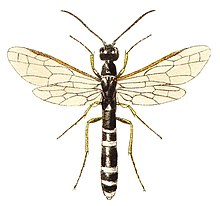
Sawflies are the insects of the suborder Symphyta within the order Hymenoptera, alongside ants, bees, and wasps. The common name comes from the saw-like appearance of the ovipositor, which the females use to cut into the plants where they lay their eggs. The name is associated especially with the Tenthredinoidea, by far the largest superfamily in the suborder, with about 7,000 known species; in the entire suborder, there are 8,000 described species in more than 800 genera. Symphyta is paraphyletic, consisting of several basal groups within the order Hymenoptera, each one rooted inside the previous group, ending with the Apocrita which are not sawflies.

Xiphydriidae are a family of wood wasps that includes around 150 species. They are located all over the world including North and South America, Australia, Europe, and others. Xiphydriidae larvae are wood borers in dead trees or branches of a range of trees. They are characterized as having long and skinny necks with dome-shaped heads. The oldest fossils of the group are from the mid Cretaceous.

The Orussidae or the parasitic wood wasps represent a small family of sawflies ("Symphyta"). Currently, about 93 extant and four fossil species are known. They take a key position in phylogenetic analyses of Hymenoptera, because they form the sister taxon of the megadiverse apocritan wasps, and the common ancestor of Orussidae + Apocrita evolved parasitism for the first time in course of the evolution of the Hymenoptera. They are also the only sawflies with carnivorous larvae.
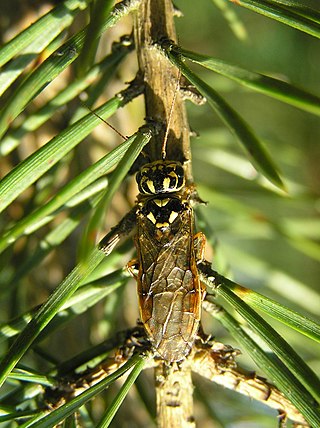
Pamphiliidae is a small wasp family within Symphyta, containing some 200 species from the temperate regions of North America and Eurasia. The larvae feed on plants, using silk to build webs or tents, or to roll leaves into tubes in which they feed, thus earning them the common names leaf-rolling sawflies or web-spinning sawflies. Some species are gregarious and the larvae live in large groups. Fossils of Pamphiliidae have been dated to the Jurassic period.

The Tenthredinoidea are the dominant superfamily of sawflies within the Symphyta, containing some 8,400 species worldwide, primarily in the family Tenthredinidae. All known larvae are phytophagous, and a number are considered pests.

Tenthredinidae is the largest family of sawflies, with well over 7,500 species worldwide, divided into 430 genera. Larvae are herbivores and typically feed on the foliage of trees and shrubs, with occasional exceptions that are leaf miners, stem borers, or gall makers. The larvae of externally feeding species resemble small caterpillars. As with all hymenopterans, common sawflies undergo complete metamorphosis.

Acantholyda is a genus of sawflies.

Nematinae is a subfamily of sawflies belonging to the family Tenthredinidae. It contains over 1250 described species in ~40 genera. Members of this subfamily feed on a wide range of plants and employ a wide range of feeding habits, both internally and externally, on their host plants.

Allantinae is a subfamily of sawflies in the family Tenthredinidae, and the largest subfamily of that family, with about 110 genera. The subfamily is considered to consist of five to six tribes, and are medium to large sawflies.
Emphytopsis is a genus of sawflies in the family Tenthredinidae.
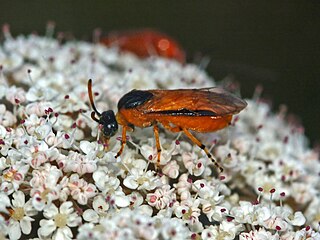
Arge is a genus of sawflies belonging to the family Argidae subfamily Arginae.

Pamphilius is a genus of leaf-rolling sawflies within the Symphyta belonging to the family Pamphiliidae.

Tenthredo is a genus of sawflies with more than 700 species of the family Tenthredinidae, subfamily Tenthredininae. It is of Holarctic distribution.
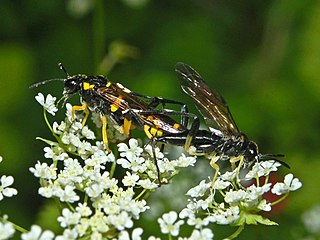
Macrophya is a genus of sawfly.

Cephidae is a family of stem sawflies in the order Hymenoptera. There are about 27 genera and more than 160 described species in Cephidae.

Blennocampinae is a subfamily of common sawflies in the family Tenthredinidae. There are more than 100 genera and 600 described species in Blennocampinae.
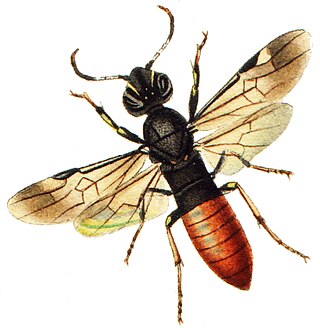
Orussus is a genus of parasitic wood wasps in the family Orussidae. There are about 30 described species in Orussus.

Pachyprotasis is a genus of common sawflies in the family Tenthredinidae. There are at least 40 described species in Pachyprotasis.

Aproceros is a genus of insects in the family Argidae. Species of this genus are native to eastern Asia with one species, the elm zigzag sawfly, that has been introduced to Europe and North America.
Adamas is a genus of sawflies belonging to the family Tenthredinidae. It is sometimes referred to in the literature under the name Dinax, but this name is a junior homonym of a name validly published in 1848; claims that the 1848 name was not validly published have been subsequently refuted.
